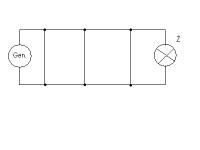Well, maybe it is also worth mentioning the capacitive galvanic isolation. It is the use of a capacitor (s) as a separator. In such a system, the direct current is separated and the variable flows (often of a specific frequency (acoustic, radio, etc.). To sum up - galvanic connection (in principle) allows the flow of all currents, and those with galvanic isolation - only some (those on which We care). As a curiosity I will give such an example of a metallic connection, but it is a specifically galvanic connection. In the picture we have a power generator and a light bulb, and everything is connected with metal (e.g. copper) in accordance with the drawing. The question is whether the bulb can shine in such a system "Perhaps, provided that the frequency of the generated current is selected so that the dimensions of the transverse connections are exactly quarter-wave lengths. This is the so-called phenomenon of metal insulators.



